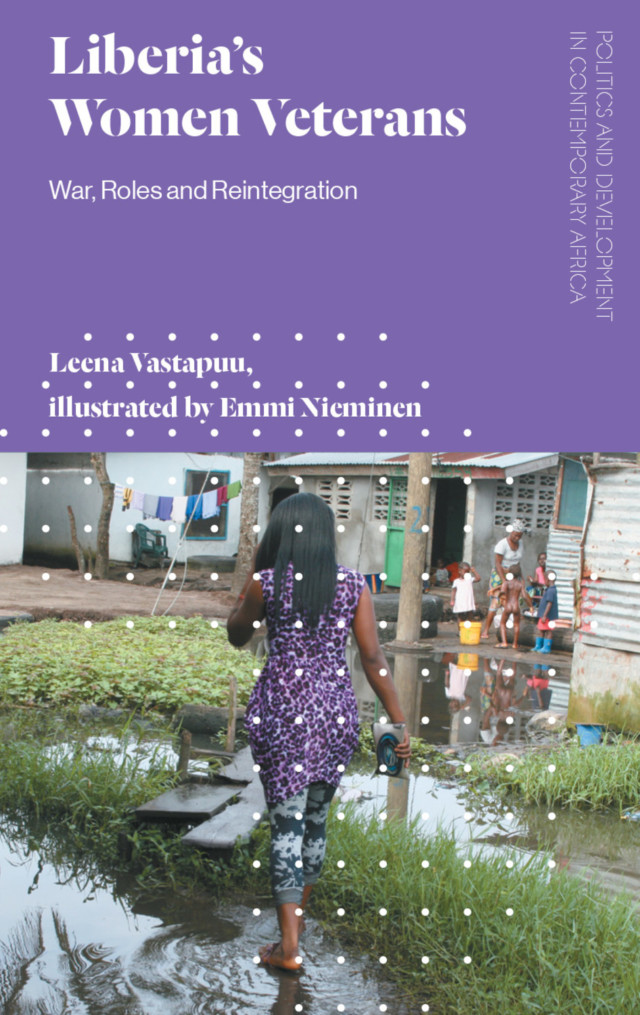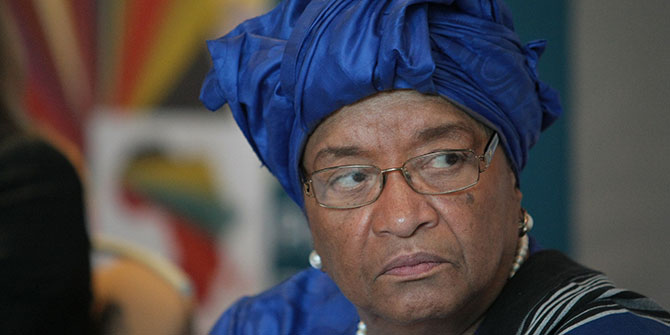Up to 40 per cent of soldiers during Liberia’s civil wars were women, but the male experience dominates the narrative. To understand the complex post-war realities of female soldiers, a new book uses an innovative an methodology that lets interviewees set the agenda.
Leena Vastapuu has written and researched widely on warfare, humanitarian issues and international development, with a particular focus on the impact of conflict on women and gender roles. This makes her well-placed to write her first book, Liberia’s Women Veterans, created together with illustrator Emmi Nieminen.
The book focusses on the First (1989–1997) and Second Liberian Civil War (2000–2003), where she argues the voices of female soldiers can no longer be ignored: ‘It is time to take girl and women soldiers seriously’ (p. 11). Although girls and young women accounted for up to 40% of the combatants in Liberia, the experiences of male soldiers are often placed at the centre of attention in current research and literature. For this reason alone, this book is a must-read.
Between 2012 and 2014, Vastapuu collected first-hand empirical data during three separate field research trips to four counties in Liberia. In total, she interviewed 133 women war veterans who took part in either one or both of Liberia’s civil wars. Vastapuu’s analysis in the book is complex and insightful, but at the same time well structured into five chronological chapters.
In the first chapter, Vastapuu explains and justifies the main methodological choices of her book. She elaborates on her exciting and innovative research methodology, a so-called ‘auto-photographic research approach’ and the ‘photo-elicitation technique’, which were carefully woven into key theoretical concepts. It takes courage for a researcher to apply this unconventional research methodology and I applaud her for doing it so well. What does this methodology entail? Vastapuu gave cameras to the interviewees and asked them to take photographs of their ‘everyday realities’ and ‘aspirations’. Afterwards, she carried out individual photo-elicitation interviews, during which the photographs were one by one placed in front of the interviewee/photographer, who provided the researcher with insights into each picture. This means that the girls and women in this research project set the agenda for the interview, instead of the researcher. They spoke for themselves through their own pictures.
In the second chapter, Vastapuu elaborates on the different roles undertaken by girls and women soldiers during Liberia’s civil wars (for example combat service support tasks, fighting and commanding), while she reassesses the usage of sex and gender-based categories. Based on her empirical findings, she argues that a classification that is based first on duties/ranks and second on sex/gender is better suited for addressing girl and women soldiers’ multiple roles within the various fighting forces (p. 43). While most of the 133 interviewed girls and women were abducted and sexually abused, Vastapuu clearly explains why female soldiers in Liberia should not be seen as ‘second-class soldiers’. These soldiers proved to be ‘active, dynamic and resilient individuals who played vital roles in the warring factions of Liberia’ (p. 53).
In the third chapter, Vastapuu provides an answer to the question of whether these roles were recognised in the Disarmament, Demobilization and Reintegration (DDR) programmes implemented after the civil wars and, if they were, how these programmes succeed in their tasks. In chapter two we learned that – unfortunately – many female war veterans ended up on the streets of Monrovia, where the practice of ‘loving’ for protection remains common. Vastapuu shows that the DDR programme did not fulfil their promises – although the official reports tell a rather different story. More controversies in relation to the DDR are highlighted in chapter three, which was sceptically entitled ‘DDR: Disarmament, Disillusionment and Remarginalization’. The main issue is that the programmes were planned without adequate contextual understanding, implemented in a manner poor and rushed. In addition, the majority of the war veterans did not take part in the activities and were pushed back into their traditional societal statuses.
The fourth chapter focuses on the types of positions and roles in which young women war veterans find themselves today, as well as their coping strategies or survival-mechanisms; many women remain traumatised and experience stigma. It is heart-breaking to read how these girls and women secure basic necessities such as food, security and health.
After all the hardships presented throughout the book, the last chapter addressed my favourite question, namely the aspirations and dreams these girls and women veterans have today. Vastapuu shows that the most persistent wish of the Liberian women veterans is to find a way to guarantee a decent future for their children. Their hope for a better tomorrow is a strong force to keep them going.
Vastapuu is perhaps a little too cautious in publishing none of the photographs of the interviewed women. Instead, she includes illustrations of Emmi Nieminen, a visual artist specialising in comics and graphic storytelling who has been exhibited all over Europe. These illustrations are beautifully drawn, but as the research relies heavily on the auto-photographic approach it would have been very interesting to see examples of the photographs included in the book. To put it in the words of the author herself: ‘Pictures … tend to be worth a thousand words’ (p. 41).
In the introduction, Vastapuu writes that she is trying to make sense of the world with her writing, teaching, consulting and voluntary work. After reading the book, I can say that she certainly succeeds. Based on data gathered over more than ten years, it provides extremely valuable insights in the role of girls and women soldiering as well as the realities of female war veterans in the global South. More importantly, Vastapuu has done in a way that is innovative and creative. The fact that she has recently (in January 2019) won a Prize for the Best International Relations Thesis in Finland over the last three years confirms my observations about the book’s quality.
I would highly recommend reading this excellent book. And please keep an eye on Vastapuu’s work in the upcoming years, as I am sure that we will hear a lot from her in the future!
Author’s website: www.annemariemiddelburg.com
Liberia’s Women Veterans: War, Roles and Reintegration by Leena Vastapuu is published by Zed Books, 2018.
Photo credit: Defense Media Activity, U.S. Air Force photo/Tech. Sgt. Robert Cloys.







Failure of truth reconciliation right in the first chapter of our nation was the reason why my nation lost the peace after the long continuing struggles . I hope that books can explain; what had led to failure of truth reconciliations right from the first chapter. otherwise the only solution to the current complications is general truth reconciliation and healing needed from few of our old leaders of first strategy.
Regards
Oyet patrick
One of the grandson of late Saturnino Olire of Torit mutiny which late to South Sudanese first strategy .